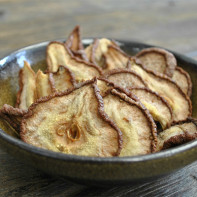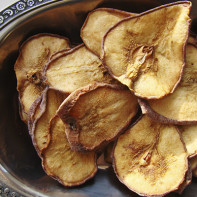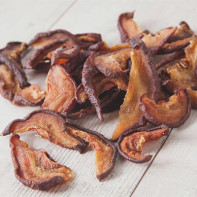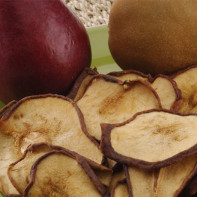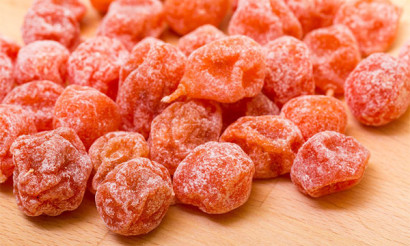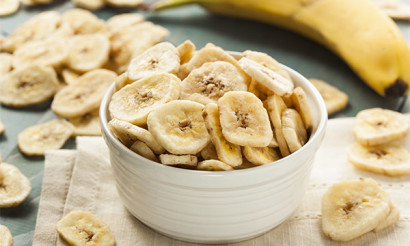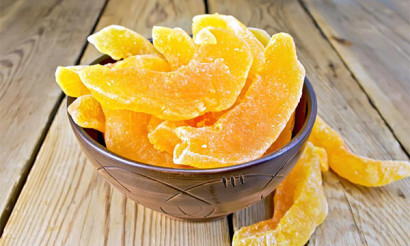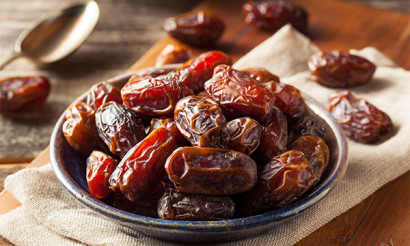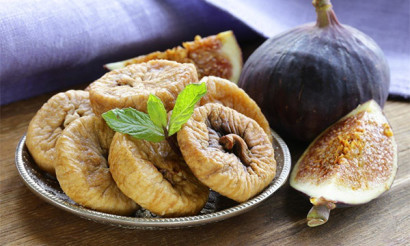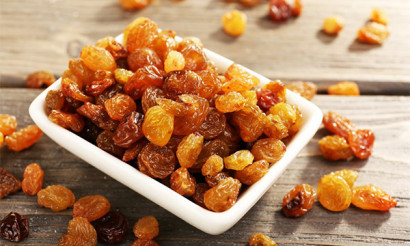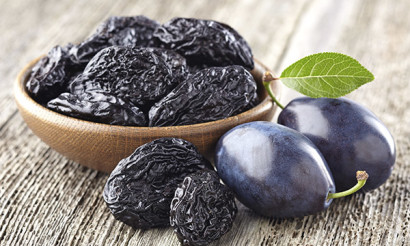Dried pears: benefits and harm to the body
The pear itself is a delicious, juicy and valuable fruit. Few people know that it has a beneficial effect on the heart, rejuvenates the skin, is a powerful immunomodulator and has many benefits for humans.
The abundance of fruit in the summer is always happy, but in the winter there are always not enough useful pears in the house. To preserve the harvest, people dry and store them. Moreover, with proper storage, nothing will happen to the fruits, so you can at any time please yourself with a pear, jam, compote, etc.
Composition and calorie content
Drying the fruit at a moderate temperature preserves in pear all the vitamins and useful properties that are sufficient for any variety. Therefore, many people who prefer to regularly use dried fruits enjoy the taste and strengthen their body at the same time.
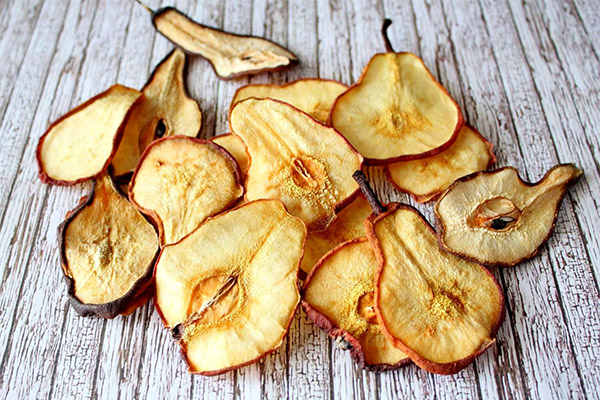
Composition:
- calories - 249;
- proteins - 2.3 g;
- fats - 0.6 g;
- carbohydrates - 62.6 g;
- dietary fiber - 6 g;
- water - 24 g.
Dried pear is rich in trace elements, phytoncides, flavonoids, sugars, fiber, iodine, organic acids and enzymes. There are many vitamins in the chemical composition, including provitamin A, C, group B, K, P, PP. Most in pears are potassium, calcium, magnesium, phosphorus, iron, manganese and copper.
A pear seems sweeter than an apple, but actually it’s even less sugar. Dried fruit is part of many diets due to its low energy value. It has little protein, but quite a lot of carbohydrates.
However, it should be remembered that 100 g of the product contains 12% of the daily calorie intake, therefore, this should be taken into account by diabetics and people who monitor their figure in the preparation of the diet.
Useful properties of dried pear
The product is not only pleasant in taste, but also very useful. Dried pears have relatively few calories and many carbohydrates that provide energy to the body. There is little sugar, but the fruit remains naturally sweet. Therefore, many doctors and nutritionists advise to use both fresh and dried pears.
Note! If the dried fruits are dried correctly, the set of minerals and vitamins is preserved.
100 g of dried pear contains 37% of the daily intake of copper, potassium (35%), magnesium (16%), manganese (16%), vitamin K (17%), phosphorus (11%), calcium (10%), iron (10%), vitamin C (9%). Accordingly, the inclusion of the product in the daily diet will make up for the lack of nutrients.
Beneficial features:
- It is believed that dried fruits act as a diuretic and disinfectant, normalize many functions and treat the pancreas. Dried fruit helps cleanse the body of heavy metals and removes toxins.
- Usually, a compote is cooked from the product, which contains tannin, which is useful for intestinal disorders (a binding effect for diarrhea), and the antibacterial properties of the drink help in the treatment of colds and sore throats.
- The abundance of potassium makes dried fruits an assistant in normalizing the work of the cardiovascular system, strengthening capillaries and blood composition.
- With fatigue, loss of appetite and mood, you should include dried pears in your diet. They are also useful for arrhythmias and regular dizziness. The point is the high iron content, due to the lack of which the problems described above are manifested. For the same reason, the pear helps with poor healing of tissues. There is even a folk recipe when people use the product, if they often have cracks in the corners of the mouth.
- Vitamins of group B contribute to the strengthening and restoration of muscles, normalize the functioning of the nervous system, as a result of which a person's general mood improves. Bones are also strengthened due to the calcium content in pears. More vitamins of group B are useful for hair, improve their growth and condition.
- There is a large amount of vitamin C and folic acid.Vitamin strengthens the immune system, protects the body from viruses, favorably affects the synthesis of certain hormones, as a whole is a powerful antioxidant, improves the function of the thyroid and pancreas. Vitamin C also slows down aging and detoxifies alcoholics.
- Since the product removes toxins, dried fruit compote helps with a hangover. It is also believed that daily use of pears improves performance.
Dried pears in medicine
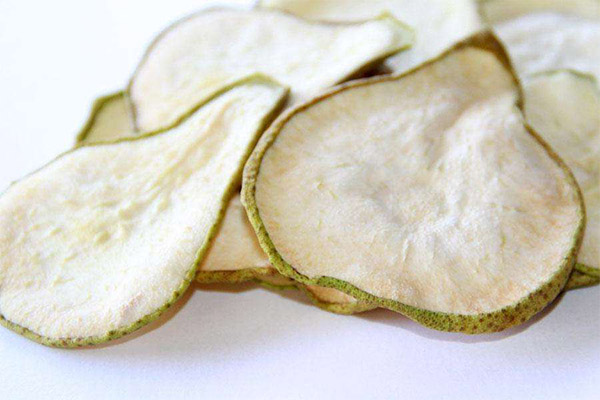
Dried pear is used mainly in folk medicine. Namely:
- at high temperature;
- as a diuretic;
- as a tonic;
- against cough.
The product is used in inflammatory processes in the kidneys and bladder, to restore the acidity of the gastric juice, suppress microbes in the intestine. And there are practically no special recipes. You just need to regularly eat the dried fruits themselves or saturated compote from them.
Also, people treat with a dried pear:
- insomnia
- obesity;
- colds and coughs;
- high cholesterol;
- fatigue
- digestive disorders;
- Depression
- problems with heart;
- disorders of the nervous system;
- headache.
Harm and contraindications
The benefits of dried pears are undoubtedly many, but there is harm. Although there are not many calories, they are a priori, so you should not abuse them daily by eating a lot of dried fruits. Especially you need to think about diabetes.
High fiber foods should not be consumed by people with stomach ulcers. And in dried pear there is enough fiber.
In general, dried fruits are hypoallergenic, however, individual intolerance can be. More often, an allergy to dried pear is found in people who are allergic to birch and alder. But there are very few such people.
How to store dried pears
The preservation of both the product itself and its beneficial properties depends on the proper storage of dried fruits. Ready-made slices are stored in a sealed sealed container, whether it be a glass or a can. The main thing is that it closes tightly. You can use plastic bags with a clasp.
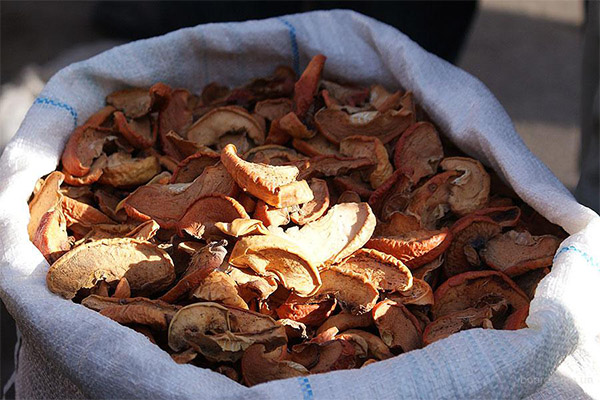
Keep pears cool and preferably in the dark. A room with ventilation, low humidity and temperature within +10 degrees is perfect. Dried fruits perfectly absorb extraneous odors, so there should not be particularly aromatic products (fish, spices, etc.) nearby. Do not place containers on the floor.
Unforeseen situations cannot be ruled out. And if insects somehow got inside the container, then you can try to correct the situation. It may turn out that the pests noticed on time did not have time to spoil the product. It is necessary to sort out the pears, throw out the damaged slices, put the rest again on a baking sheet and dry in the oven for half an hour with a temperature of 60 degrees. Another enemy is mold. If the dried fruit was hit by a fungus, then it is better to throw everything away.
In an appropriate place, under optimal conditions and in a sealed container, dried fruits can be stored for up to a year. If they just lie in the apartment, then due to the high temperature and humidity, the bacteria will multiply rapidly, and after 2-4 weeks the pear will become moldy.
How to Dry Pears at Home
Everyone can successfully make dried fruits from pears at home. Usually, slightly unripe fruits with dense pulp are used, but not very juicy. It is better not to use “astringent” varieties in the mouth with plenty of seeds. Sweet summer varieties are well suited: Ilyinka, Forest Beauty, Fragrant, Lemon, Zaporizhzhya.
Collect medium-sized fruits, wash and boil. Each makes drying in his own way, but many chop the pear, first cutting into 4 parts to remove seeds, and then into slices. Then the product is moistened in wine vinegar (1%) to avoid further darkening.
Pears should not be stored for more than 2 days before drying, otherwise they will be unusable. Before drying, it is necessary to slightly fry the fruits, throwing them in boiling water for a while. In this case, if desired, add sugar to the pot with boiling water.
After 10-15 minutes of cooking, the fruit is taken out, allowed to cool, and then cut into slices if necessary. Then the wedges dry. It is at this stage that it is desirable to treat them with wine vinegar.
There are several drying methods:
- natural method;
- oven;
- special electric dryer;
- microwave.
In the warmer regions of the country, you can easily dry pears in early autumn. This is especially important, because the longer the pear ripened or lay, the more nutrients accumulated in it. People living in private homes just leave the fruits on the roof for the whole day.
But in cold regions there is the opportunity to cook dried fruits, since almost everyone has a microwave or at least an oven.
With the natural method, the slices are laid out on a sieve (tray, baking sheet) and left in the sun so that dust does not fall on them. When the sun sets, the pears are covered with polyethylene and brought home. After a couple of days of drying, the fruits are laid out in a shaded place for 3 days for drying, periodically turning over.
With an oven, drying is done directly in the kitchen. Slices are laid on a baking sheet and dried for 2 hours at a temperature of 55-60 degrees. Next, the temperature is increased by 20 degrees. So whole fruits should be dried for about a day (12-16 hours, if it is wedges).
There are special electric dryers with trays and autonomous operation: uniform automatic circulation of warm air. This is very convenient, you just need to put the fruits on the tray and wait for the end result.
The fastest drying is in the microwave. In a few minutes, the portion is ready, but there is a risk of miscalculating and overdrying the product. There is no exact recipe, since it all depends on the capacity of the furnace. Begin by drying for 2.5 minutes with a power of 200 watts. If this is not enough, then the process is repeated for 30 seconds. When the slices become elastic and springy, then everything is ready.
Some people prefer to dry whole pears without dividing them into slices. The process is completely similar, but the difference is only in time. It makes sense to dry the whole fruit if the fruits are small. Keep in the sun whole fruits will take about a week.
In the oven, whole pears will be ready in about 20 hours with constant turning. It should be dried until the fruits turn brown. With good ventilation, dried fruits will be ready in 8-10 hours.
A wild pear can also be successfully dried at home. But you need to follow the rule: you can not pick fruits from the trees. It is necessary to collect the fallen pears, put in a container (for example, in a bucket) and let it rest. Readiness for drying is determined by taste and color. When the fruit has become aromatic-sweet, and its skin is brown, then it is time to make dried fruits.
How to cook dried pear compote
Dried fruits are eaten like that, but more often they cook tasty compote from them. The recipe for a classic dried pear compote is simple.
The following components are required:
- dried fruits - 200 g;
- sugar - 100 g;
- citric acid - 1 g;
- water - 1 l.
Cooking will take about half an hour, and in the end you will get compote for 4 servings. Rinse dried fruits thoroughly in boiling water and put in a saucepan. Pour everything with a liter of water, cover, bring to a boil and cook over low heat for about 30–35 minutes.
After sugar and citric acid are added, everything is mixed, and then cooled. Compote turns out tasty and rich.
Interesting facts about pears
Everyone ate tasty, juicy pears, but few know interesting facts about them:
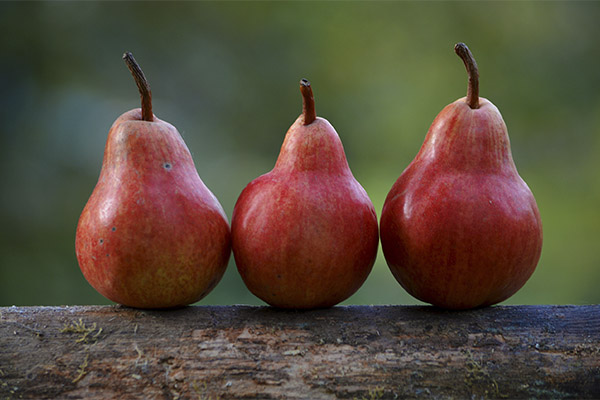
- Pears appeared in South Asia. Fruit came to Europe before our era, but to America relatively recently - 400 years ago.
- The ancient Greeks considered pears a gift of the gods and thanked them, bearing fruit as a gift to Aphrodite.
- Pear and rose are relatives, since both plants are rosaceae. Also, the pear is a sister to hawthorn.
- The ancient Chinese considered the pear a symbol of immortality because of strength. And now furniture, musical instruments, kitchen appliances, etc. are made from its wood.
- Until Columbus brought tobacco to the continent, the local Indians smoked the dried pear leaves.
- An interesting fact is that the leaves on the branch grow at a certain angle: each leaf is located at an angle of 135 degrees from each other. So the plant receives maximum moisture and sunlight.
- If you regularly eat fresh pears, then your teeth will become noticeably stronger due to the high content of calcium and phosphorus.
- The fetus does not cause allergies. The percentage of allergy sufferers who have a reaction to a pear is negligible.
- In Japan, the largest pear fruit was grown, which weighed 3 kilograms.
- Fruit is a natural antiseptic. Gastroenterologists even advise eating a pear separately from meals to get rid of harmful microorganisms in the intestines.
Dried pears should be prepared by everyone whenever possible. And the point here is not a fresh compote from a natural product in winter, but that a dried pear strengthens the body, protects against bacteria, removes harmful substances, and also has a lot of vitamins and beneficial compounds.
«Important: all information on the site is provided exclusively in fact-finding purposes. Before applying any recommendations, consult with a profile specialist. Neither the editors nor the authors are liable for any possible harm caused materials. "

